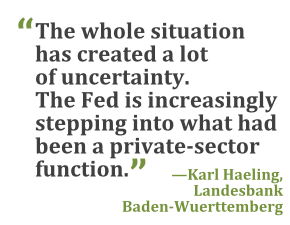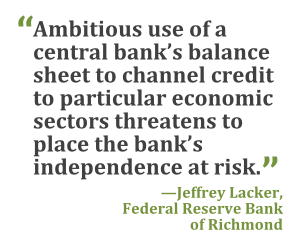Federal Reserve officials, concerned that selling bonds from their $4.3 trillion portfolio could crush the U.S. recovery, are preparing to keep their balance sheet close to record levels for years.
Central bankers are stepping back from a three-year-old strategy for an exit from the unprecedented easing they deployed to battle the worst recession since the Great Depression. Minutes of their last meeting in April made no mention of asset sales.
Officials worry that such sales would spark an abrupt increase in long-term interest rates, making it more expensive for consumers to buy goods on credit and companies to invest, according to James Bullard, president of the Federal Reserve Bank of St. Louis.
That “is a widespread view in parts of the Fed, I think, and in financial markets,” Bullard said in an interview last week. While he disagrees with that perspective, it “won the day.”
 The Fed is testing new tools that would allow it to keep a large balance sheet even after it raises short-term interest rates, a step policy makers anticipate taking next year. They would use these tools to drain excess reserves temporarily from the banking system.
The Fed is testing new tools that would allow it to keep a large balance sheet even after it raises short-term interest rates, a step policy makers anticipate taking next year. They would use these tools to drain excess reserves temporarily from the banking system.
“It is pretty clear they are anticipating operating in a situation with a lot of reserves and a high balance sheet for a long time,” said former Fed governor Laurence Meyer, a co-founder of Macroeconomic Advisers LLC, a St. Louis-based forecasting firm.
The strategy, which would make the Fed one of the biggest players in money markets, carries risks. In a time of crisis, investors could flock to safe short-term instruments created by the Fed, potentially starving the rest of the financial system of funding.
“The whole situation has created a lot of uncertainty,” said Karl Haeling, head of strategic debt distribution at Landesbank Baden-Wuerttemberg in New York. “The Fed is increasingly stepping into what had been a private-sector function.”
The Fed's asset purchases have expanded its balance sheet to 25 percent of gross domestic product (GDP) from 6 percent at the start of 2007. Central banks from Japan to the U.K. also will have to develop strategies for operating with large portfolios. For example, the Bank of England's is 24 percent of GDP, up from about 6 percent in 2007.
Fed officials led by Chair Janet Yellen, who meet June 17-18, anticipate raising their benchmark federal funds rate next year for the first time since 2006. They will release new forecasts for the economy and the outlook for the benchmark after next week's meeting.
Strategic Shift
Maintaining a large balance sheet in a tightening period would mark a strategic shift for the Fed and reverse much of central banking doctrine from the 1990s and early 2000s, which favored minimal interference in the economy.
Under then-Chairman Alan Greenspan, the Fed targeted the fed funds rate, the cost of overnight loans among banks, and left most other interest rates to markets. Officials avoided subsidizing credit to specific industries, such as housing, to avoid opening a Pandora's Box of requests to aid other sectors.
That changed after the collapse of Lehman Brothers Holdings Inc. in 2008, when the central bank cut the fed funds rate almost to zero. Seeking more ways to stimulate growth, the Fed then began an effort to influence longer-term rates on home loans and other debt with purchases of longer-term Treasuries, mortgage-backed securities, and housing-agency debt.
“Ambitious use of a central bank's balance sheet to channel credit to particular economic sectors or entities threatens to entangle the central bank in distributional politics and place the bank's independence at risk,” Richmond Fed president Jeffrey Lacker, one of the biggest internal critics of the policy, said in a May 13 speech.
The Fed's purchases created $2.54 trillion of bank reserves in excess of what lenders are required to hold against deposits. The central bank needs to tie up or extinguish that money to raise the short-term interest rate above its current range of zero to 0.25 percent.
 Toward that end, Fed officials in June 2011 adopted an exit strategy that aimed to return the balance sheet to its pre-crisis size. The strategy called first for allowing the balance sheet to shrink gradually as assets matured. The Fed later would raise the short-term rate and then slowly start to sell assets, focusing on ridding the portfolio of housing debt.
Toward that end, Fed officials in June 2011 adopted an exit strategy that aimed to return the balance sheet to its pre-crisis size. The strategy called first for allowing the balance sheet to shrink gradually as assets matured. The Fed later would raise the short-term rate and then slowly start to sell assets, focusing on ridding the portfolio of housing debt.
'Smallest Levels'
The size of the balance sheet and quantity of bank reserves were to be “reduced to the smallest levels that would be consistent with the efficient implementation of monetary policy,” according to minutes of the meeting.
The strategy started to change last June, when then-Chairman Ben S. Bernanke said most officials didn't favor selling the Fed's portfolio of housing debt, now valued at $1.6 trillion. Instead, the portfolio would be allowed to shrink gradually as the bonds matured.
William C. Dudley, president of the New York Fed and vice chairman of the Federal Open Market Committee, went further in a May 20 speech, saying the central bank should continue to reinvest maturing debt even after it raises interest rates.
Not all Fed officials agree. “Allowing the balance sheet to decline due to 'passive runoff'—which stops reinvesting the maturing securities—prior to the first rate hike is appropriate,” Kansas City Fed President Esther George said in a June 3 speech in Colorado.
Expectations that the Fed will refrain from selling assets have helped drive yields on 10-year Treasury notes down to 2.64 percent late yesterday, from 3.03 percent at the end of last year. A Treasuries selloff pushed yields on those notes to the highest level in four weeks before the U.S. sells $21 billion of the securities today.
The Fed's portfolio “matures, it pays down, but it doesn't get sold,” said Deborah Cunningham, chief investment officer for global money markets at Federated Investors Inc. in Pittsburgh, which manages $366 billion.
The reason, according to Cunningham: Officials want to avoid a repeat of the “violent reaction” when Bernanke said last June that the Fed would begin to taper its asset purchases soon. Ten-year Treasury yields jumped 0.81 percentage points in less than three months after those comments, and 30-year mortgage rates increased by 0.66 point.
Housing markets sputtered. After boosting the economy for 12 straight quarters, residential investment subtracted 0.26 percentage point from growth in the fourth quarter of 2013 and 0.18 point in the first period of this year, when the economy as a whole contracted.
“The reaction would be 10 times worse” if the Fed decided to sell securities, Cunningham said. “I don't think they want to risk that.”
Monthly Pace
The Fed has since started reducing the monthly pace of bond purchases, now $45 billion, and is on course to end them late this year. That still will leave the Fed with trillions of excess cash to soak up.
One way to tie up that money would be to raise the interest rate the Fed pays on excess reserves, currently 0.25 percent. Yet because banks aren't the only participants in the federal funds market, the Fed also intends to absorb cash held by federal home-loan banks and mutual funds.
It would do that with reverse repurchase agreements, giving counterparties securities in exchange for overnight loans of cash. The transactions later would be reversed.
For the first time, investment management companies such as BlackRock Advisors LLC and the Vanguard Group Inc. would be able to lend cash directly to the Fed.
Lou Crandall, chief economist at Wrightson ICAP LLC, who has been watching money markets and Fed policy for three decades, compared the importance of the shift in strategy with the Fed's decision to establish a monopoly on bank-note issuance after its founding in 1913.
One reason the Fed may stick with the strategy for a long time: It would provide safe assets that banks need to fulfill stricter requirements for capital and liquidity imposed by regulators since the financial crisis.
“One of the fundamental tenets of financial reform is that everybody is required to hold a lot of liquidity and nobody is allowed to provide it,” said Crandall, who is based in Jersey City, New Jersey. “The Fed has bridged the gap.”
A large balance sheet with U.S. Treasury and mortgage-backed securities has other benefits for the Fed.
It provides “continuing options for impacting long-term interest rates,” Eric Rosengren, president of the Boston Fed, said at a conference this week in Guatemala City.
Meyer said the FOMC now doesn't appear worried about having a big balance sheet, and many officials “prefer to operate at a higher level of reserves.”
“There is a preference emerging to say, 'This works,'” Meyer said. “The question is: Do they ever want to get back to normal?”
© 2025 ALM Global, LLC, All Rights Reserved. Request academic re-use from www.copyright.com. All other uses, submit a request to [email protected]. For more information visit Asset & Logo Licensing.




